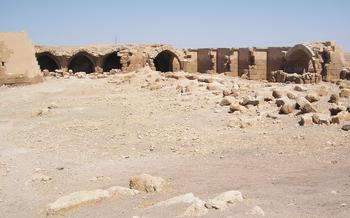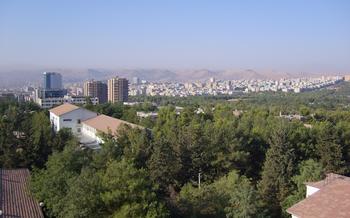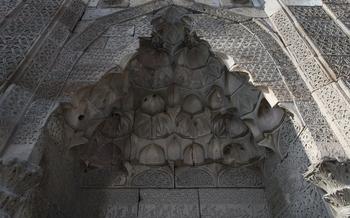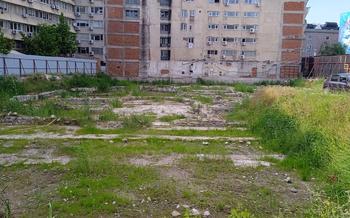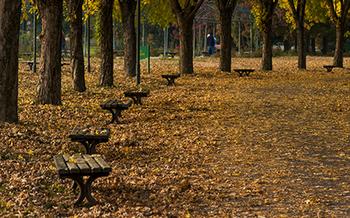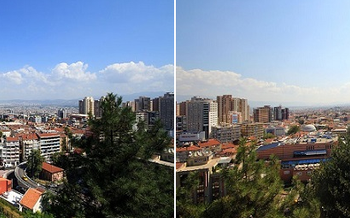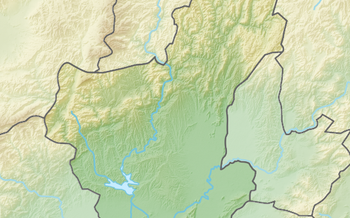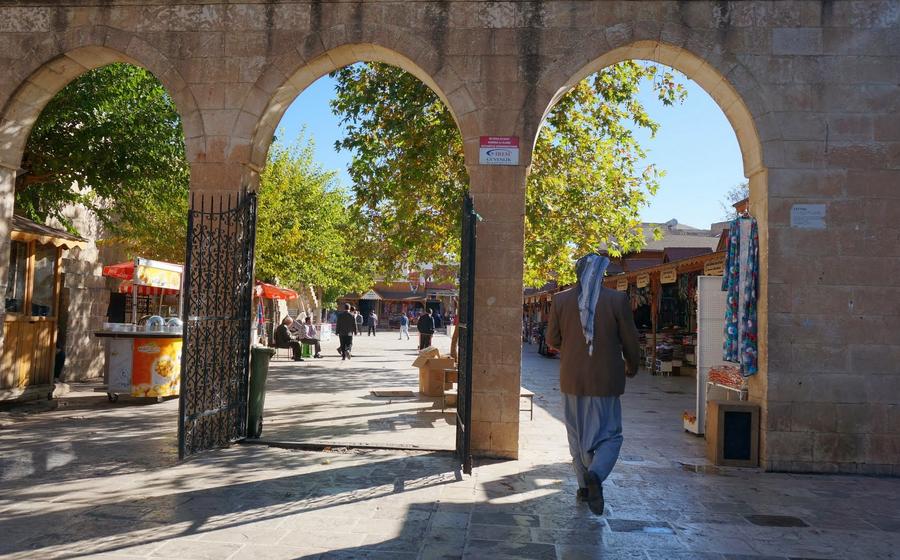
Museum of Turkish Bath Culture
- History of the Turkish Bath Culture Museum
- Location and Accessibility
- Exhibits and Displays
- Health Benefits of Turkish Baths
- Cultural Significance of Turkish Baths
- Architecture and Design
- Educational Programs and Workshops:
- Souvenir Shop and Local Crafts
- Nearby Attractions
- Food and Dining Options
- Accessibility for Disabled Visitors
- Photography and Social Media
- Insider Tip: Unveiling the Secret Chamber
History of the Turkish Bath Culture Museum
The Museum of Turkish Bath Culture, nestled in the heart of Şanlıurfa, is a testament to the rich history and cultural significance of Turkish baths, deeply interwoven with Turkish society for centuries. Established in 2014, the museum serves as a guardian of this ancient tradition, preserving and showcasing the heritage of Turkish bath culture for future generations.
Housed in a beautifully restored historical building, the museum's architecture reflects the essence of traditional Turkish baths, with intricate tilework, vaulted ceilings, and marble interiors. Visitors are transported back in time as they step into the museum, immersing themselves in the ambiance of this cultural landmark.
The museum's establishment is a testament to the recognition of Turkish baths as a vital part of Turkish history and identity. Through its exhibits and displays, the museum aims to educate and inform visitors about the evolution of Turkish bath traditions, their social and cultural significance, and their impact on Turkish society throughout the ages.
Location and Accessibility
The Museum of Turkish Bath Culture is conveniently located in the heart of Şanlıurfa, making it easily accessible for visitors. Situated at [Exact Address], the museum is just a short walk from other prominent tourist attractions and landmarks in the city. Visitors can easily reach the museum on foot, by taxi, or by using the city's public transportation system. For those driving, there are designated parking spaces available nearby. Whether exploring the city on foot or using public transport, the museum's central location ensures a hassle-free visit for all. To enhance your navigation experience, we recommend using a map or following the provided directions to reach the museum without any inconvenience.
Exhibits and Displays
The Museum of Turkish Bath Culture houses a diverse collection of exhibits and displays that vividly showcase the history, traditions, and practices of Turkish baths. Visitors can immerse themselves in the rich cultural heritage of these bathing rituals through interactive exhibits, multimedia presentations, and historical artifacts.
The museum features a replica of a traditional Turkish bath, complete with its distinct sections, including the changing room, hot room, and cold room. Visitors can gain insights into the various stages of the bathing process, from the initial cleansing to the relaxing massage and final cooling down.
Among the highlights of the museum's collection are historical artifacts such as copper basins, marble slabs, and ornate faucets that were used in traditional Turkish baths. These objects provide a tangible connection to the past and showcase the intricate craftsmanship and attention to detail that went into the design of these bathing spaces.
Interactive exhibits and multimedia presentations further enhance the visitor experience, offering a deeper understanding of the cultural significance of Turkish baths. Visitors can learn about the history of these bathing rituals, their role in society, and the various health benefits associated with them.
Health Benefits of Turkish Baths
Turkish baths are not only a cultural experience but also a therapeutic one. The combination of heat, steam, and massage in Turkish baths offers a range of health benefits that have been recognized for centuries.
The high temperatures and humidity in Turkish baths promote deep sweating, which helps to detoxify the body by eliminating harmful toxins and impurities through the skin. The steam inhalation aids in clearing nasal congestion, easing respiratory problems, and improving overall lung function.
The massage techniques employed by the "tellak" or bath attendant help to relax tense muscles, improve circulation, and alleviate pain and stiffness in the joints. The gentle massage also stimulates the lymphatic system, which is responsible for draining waste and toxins from the body.
Turkish baths have been shown to have a positive impact on cardiovascular health by reducing blood pressure, improving circulation, and lowering cholesterol levels. The heat and steam help to dilate blood vessels, allowing for better blood flow throughout the body.
In addition, Turkish baths offer a relaxing and stress-relieving experience. The warm, humid environment and the soothing massage help to calm the mind and reduce anxiety and stress levels. The combination of heat, steam, and massage promotes a sense of well-being and tranquility.
Cultural Significance of Turkish Baths
Turkish baths hold a deep-rooted cultural significance in Turkish society, extending beyond their practical function as bathing facilities. They have served as social gathering places for centuries, fostering a sense of community and connection among people from all walks of life.
In traditional Turkish culture, baths were not just for cleansing the body but also for socializing, relaxing, and rejuvenating the mind and spirit. They were places where people could come together to share stories, exchange news, and catch up on community happenings.
Baths also played an important role in significant life events and rituals. For example, brides-to-be would often visit the bath before their wedding day for a special "bridal bath" ceremony, where they were pampered with massages, exfoliation treatments, and henna decorations.
The cultural significance of Turkish baths is still evident today, as they continue to be popular gathering places for locals and tourists alike. Visiting a Turkish bath is not just about experiencing a unique bathing ritual but also about immersing oneself in the rich cultural traditions of Turkey.
Architecture and Design
The Museum of Turkish Bath Culture is housed in a stunning historical building that showcases the unique architectural features of traditional Turkish baths. Built in the 19th century, the museum's architecture blends Ottoman and Seljuk influences, creating a visually captivating space. The entrance to the museum is adorned with intricate carvings and arches, hinting at the rich cultural heritage within.
Inside, visitors are greeted by a spacious courtyard surrounded by elegant arched galleries. The central dome of the building rises high above, allowing natural light to flood the interior. The walls are adorned with colorful tiles and intricate paintings that depict scenes from Turkish bath rituals and daily life.
One of the highlights of the museum's architecture is the beautifully preserved bathing chambers. These chambers feature marble platforms, raised basins, and intricate water spouts that demonstrate the sophisticated plumbing systems used in traditional Turkish baths. Visitors can also admire the stunning stained-glass windows that cast a warm and colorful glow throughout the space.
The Museum of Turkish Bath Culture's architecture not only serves a functional purpose but also adds to the overall ambiance and experience of the museum. The harmonious blend of historical and modern elements creates a truly immersive and memorable visit for all who step through its doors.
Educational Programs and Workshops:
The Museum of Turkish Bath Culture offers a range of educational programs and workshops that provide visitors with an immersive and interactive learning experience. These programs are designed to deepen understanding of the Turkish bath culture, its historical significance, and its contemporary relevance.
One of the most popular programs is the "Traditional Turkish Bath Ritual" workshop, which allows participants to experience a traditional Turkish bath under the guidance of an experienced "tellak" or bath attendant. Participants learn about the different stages of the bath ritual, including the warm-up, exfoliation, massage, and cooling down. They also gain insights into the cultural significance of the Turkish bath and its role in Turkish society.
Another popular program is the "History of Turkish Baths" lecture, which provides an overview of the development of Turkish baths from their ancient origins to their modern-day iterations. Participants learn about the architectural features, design elements, and cultural practices associated with Turkish baths throughout history.
The museum also offers hands-on workshops on traditional Turkish crafts, such as soap making and towel weaving. These workshops provide visitors with an opportunity to learn about the techniques and materials used in these traditional crafts and to create their own unique souvenirs.
By participating in these educational programs and workshops, visitors can gain a deeper understanding of the Turkish bath culture and its significance in Turkish society, while also experiencing the unique atmosphere and traditions of a traditional Turkish bath.
Souvenir Shop and Local Crafts
Within the Museum of Turkish Bath Culture, visitors will find a charming souvenir shop that offers a treasure trove of unique and locally-made crafts. These souvenirs serve as a tangible reminder of the rich Turkish bath culture and the artistry of Şanlıurfa. From intricately designed copper bowls and traditional towels to handcrafted soaps and essential oils, each item is a testament to the skill and creativity of local artisans.
One of the highlights of the souvenir shop is the selection of hand-painted ceramics. These vibrant and colorful pieces depict scenes from Turkish bath rituals, capturing the essence of this ancient tradition. Visitors can also find a variety of textiles, including beautifully embroidered towels and peshtemals, which are traditional Turkish bath wraps.
Supporting the local artisans who create these unique souvenirs is an important way to preserve traditional crafts and ensure their continued existence. By purchasing a handcrafted item from the museum's shop, visitors not only take home a memorable souvenir but also contribute to the preservation of Turkey's rich cultural heritage.
My personal recommendation is to look out for the hand-carved wooden bowls and trays. These exquisite pieces are made from local woods and feature intricate designs that showcase the artistry of the region. Each bowl or tray is a unique work of art that will add a touch of Turkish charm to any home.
Nearby Attractions
The Museum of Turkish Bath Culture is strategically located in the heart of Şanlıurfa, surrounded by a wealth of historical and cultural attractions. A short walk from the museum, visitors can explore the iconic Şanlıurfa Castle, a magnificent fortress that offers breathtaking panoramic views of the city. For a glimpse into the region's rich history, head to the Şanlıurfa Museum, which houses an impressive collection of artifacts from ancient civilizations.
Nature enthusiasts will delight in the Balıklıgöl, a sacred pool filled with thousands of carp fish that are believed to have healing properties. The Göbekli Tepe, located just outside the city, is a UNESCO World Heritage Site and one of the oldest known temples in the world, dating back to the 10th millennium BC.
For a unique culinary experience, visitors can indulge in the flavors of traditional Turkish cuisine at the Şanlıurfa Kebabı Restaurant, renowned for its mouthwatering kebabs and local delicacies. A visit to the Şanlıurfa Bazaar is a must for those seeking authentic souvenirs and handicrafts, from intricate copperware to colorful textiles.
By combining a visit to the Museum of Turkish Bath Culture with these nearby attractions, visitors can immerse themselves in the rich cultural heritage, historical wonders, and culinary delights that Şanlıurfa has to offer.
Food and Dining Options
After immersing yourself in the history and culture of Turkish baths, you can satisfy your taste buds with the delectable culinary offerings of Şanlıurfa. The city is renowned for its rich and flavorful cuisine, influenced by its diverse cultural heritage.
Just a stone's throw from the Museum of Turkish Bath Culture, you'll find an array of local restaurants and eateries waiting to tantalize your palate. Indulge in the aromatic kebabs, freshly grilled on skewers and infused with local spices. Savor the melt-in-your-mouth "lahmacun," a crispy flatbread topped with minced meat and vegetables. Don't miss the chance to try "içli köfte," a specialty of the region, consisting of bulgur dumplings filled with ground meat and herbs.
For a truly unique dining experience, head to one of the traditional "han" restaurants. These historic inns, once used by travelers and merchants, have been transformed into culinary havens, offering a taste of Şanlıurfa's culinary heritage. Immerse yourself in the ambiance of these charming establishments, adorned with intricate tilework and traditional Turkish décor, as you savor the flavors of authentic Turkish cuisine.
Whether you prefer a casual meal or a more elaborate dining experience, Şanlıurfa has something to offer every palate. Be sure to ask for recommendations from the locals, who will gladly guide you to the best hidden gems where you can sample the true essence of Şanlıurfa's culinary delights.
Accessibility for Disabled Visitors
The Museum of Turkish Bath Culture recognizes the importance of accessibility for all visitors, including those with disabilities. The museum is committed to providing a welcoming and inclusive environment for everyone. Wheelchair accessibility is ensured throughout the museum, with ramps and elevators connecting different levels. Designated parking spaces are available for disabled visitors close to the museum entrance. The museum staff is trained to assist visitors with disabilities and can provide any necessary assistance or information. Visitors with disabilities can request assistance with navigation, exhibits, or any other aspect of their visit. The museum encourages visitors to reach out to the staff if they have any specific needs or concerns, as they are dedicated to making the museum experience accessible and enjoyable for all visitors.
Photography and Social Media
The Museum of Turkish Bath Culture encourages visitors to capture their experiences and share them with the world. Photography is allowed inside the museum, but visitors are kindly requested to be respectful of other visitors and the exhibits. Using flash photography or tripods is not permitted to avoid disturbing other visitors or damaging the artifacts.
When sharing photos or videos on social media, visitors are encouraged to tag the museum (@TurkishBathMuseum) and use relevant hashtags (#TurkishBathCulture, #Şanlıurfa, #MuseumVisit). This helps promote the museum and allows others to discover and appreciate the rich history and beauty of Turkish bath culture.
For those seeking unique photo opportunities, the museum's courtyard offers a picturesque backdrop with traditional architectural elements and lush greenery. The intricate tilework, vaulted ceilings, and decorative niches provide stunning visual elements for capturing memorable photos. Visitors can also take advantage of the natural light streaming through the skylights to create beautiful and vibrant images.
Insider Tip: Unveiling the Secret Chamber
As you explore the fascinating exhibits of the Museum of Turkish Bath Culture, keep an eye out for a hidden gem tucked away from the main galleries. In an unassuming corner, you'll find a secret chamber that holds a treasure trove of artifacts and stories waiting to be discovered.
This hidden chamber is a testament to the rich history and cultural significance of Turkish baths. Here, you'll find ancient bathing tools, intricate tiles, and personal items that once belonged to bathhouse patrons. The walls are adorned with historical photographs and documents that provide a glimpse into the lives of those who frequented these sacred spaces.
The secret chamber is a place of wonder and discovery, where you can delve deeper into the traditions and rituals of Turkish baths. It's a reminder that there's always more to uncover, even in the most familiar places. So, take your time, explore every nook and cranny, and let the museum's secrets transport you back in time.

